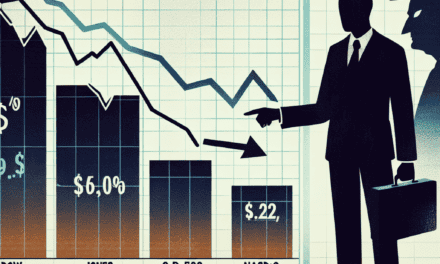“Navigating Turbulence: Markets Uncertain as Stocks Slide and Dollar Gains Ground Amid Fed Speculation.”
Introduction
In a climate marked by heightened volatility, financial markets are grappling with uncertainty as stock prices decline and the U.S. dollar strengthens. This shift comes amid growing speculation surrounding the Federal Reserve’s monetary policy decisions, particularly regarding interest rates. Investors are navigating a complex landscape influenced by economic indicators, geopolitical tensions, and inflationary pressures, leading to a cautious approach in equity markets. As traders reassess their strategies, the interplay between stock performance and currency strength underscores the challenges faced in an unpredictable economic environment.
Market Volatility: Understanding the Current Landscape
In recent weeks, market volatility has become a defining characteristic of the financial landscape, as investors grapple with a confluence of factors that have led to a decline in stock prices and a strengthening of the U.S. dollar. This uncertainty is largely driven by speculation surrounding the Federal Reserve’s monetary policy, which has left many market participants questioning the future trajectory of interest rates and economic growth. As the Fed continues to navigate the complexities of inflation and employment, its decisions have far-reaching implications for both domestic and global markets.
To begin with, the decline in stock prices can be attributed to a variety of influences, including rising interest rates and persistent inflationary pressures. As the Fed signals its intent to maintain a hawkish stance, investors are increasingly concerned about the potential for higher borrowing costs, which could dampen consumer spending and corporate investment. This apprehension is reflected in the performance of major indices, which have experienced significant fluctuations as traders react to economic data releases and Fed communications. Consequently, the uncertainty surrounding the Fed’s next moves has led to a cautious approach among investors, resulting in a sell-off in equities.
Moreover, the strengthening of the U.S. dollar adds another layer of complexity to the current market environment. As the dollar appreciates, it can create headwinds for U.S. exporters, making their goods more expensive in foreign markets. This dynamic can lead to a decline in corporate earnings for companies that rely heavily on international sales, further contributing to the bearish sentiment in the stock market. Additionally, a stronger dollar often attracts foreign investment, as it offers better returns compared to other currencies. This influx of capital can exacerbate volatility, as investors shift their focus between asset classes in response to changing economic conditions.
Transitioning to the broader economic context, it is essential to consider the implications of the Fed’s policy decisions on inflation and employment. The central bank’s dual mandate aims to promote maximum employment while stabilizing prices, a balancing act that has become increasingly challenging in the current economic climate. As inflation remains elevated, the Fed faces pressure to act decisively to rein in price growth. However, aggressive rate hikes could stifle economic expansion and lead to job losses, creating a delicate situation for policymakers. This uncertainty surrounding the Fed’s approach has left investors on edge, as they attempt to anticipate the potential outcomes of future meetings.
In light of these developments, market participants are advised to remain vigilant and adaptable. The current landscape is characterized by rapid changes and unpredictable shifts, necessitating a keen awareness of both macroeconomic indicators and geopolitical events. As the Fed continues to communicate its policy intentions, investors must be prepared for potential market reactions that could arise from unexpected announcements or data releases. Furthermore, diversification remains a critical strategy in navigating this volatile environment, as it can help mitigate risks associated with concentrated positions in equities or other asset classes.
In conclusion, the current market volatility underscores the intricate interplay between monetary policy, economic indicators, and investor sentiment. As stocks decline and the dollar strengthens amid ongoing speculation about the Fed’s next moves, understanding these dynamics is crucial for making informed investment decisions. By staying attuned to the evolving landscape, investors can better position themselves to navigate the uncertainties that lie ahead.
The Impact of a Strengthening Dollar on Global Trade
The strengthening of the U.S. dollar has significant implications for global trade, influencing various economic dynamics across nations. As the dollar appreciates, it alters the competitive landscape for exporters and importers alike, creating a ripple effect that can be felt in economies around the world. When the dollar gains strength, U.S. goods become more expensive for foreign buyers, which can lead to a decline in exports. This situation poses challenges for American manufacturers and producers who rely on international markets for their sales. Consequently, a decrease in exports can negatively impact domestic economic growth, as companies may face reduced revenues and, in turn, may be compelled to cut back on production or workforce.
Moreover, the impact of a stronger dollar extends beyond the borders of the United States. Countries that rely heavily on exports to the U.S. may find their products less competitive in the American market, leading to potential economic slowdowns. For instance, nations in emerging markets that export commodities or manufactured goods to the U.S. may experience a decline in demand, which can adversely affect their economic stability. This scenario is particularly concerning for countries that have dollar-denominated debts, as a stronger dollar increases the cost of servicing these obligations, potentially leading to financial distress.
In addition to affecting exports, a strengthening dollar also influences import dynamics. As the dollar appreciates, foreign goods become cheaper for American consumers and businesses. This situation can lead to an increase in imports, which may further exacerbate trade imbalances. While consumers may benefit from lower prices on imported goods, domestic producers may struggle to compete with the influx of cheaper foreign products. This shift can lead to job losses in certain sectors, particularly those that are unable to adapt to the changing competitive environment.
Furthermore, the strengthening dollar can have implications for global commodity prices. Many commodities, including oil and gold, are priced in dollars, meaning that as the dollar strengthens, the prices of these commodities tend to decline for foreign buyers. This phenomenon can lead to reduced revenues for commodity-exporting countries, which may rely on stable or rising prices to support their economies. Consequently, these nations may face budgetary pressures and economic challenges, particularly if they are heavily dependent on commodity exports.
Additionally, the impact of a stronger dollar is not uniform across all economies. While some countries may experience adverse effects, others may benefit from the situation. For instance, countries that import a significant amount of goods from the U.S. may find their purchasing power enhanced, allowing them to acquire more goods at lower costs. This dynamic can stimulate consumption and investment in those economies, potentially leading to growth.
In conclusion, the strengthening of the U.S. dollar has far-reaching consequences for global trade, affecting export competitiveness, import dynamics, and commodity prices. As nations navigate these complexities, the interconnectedness of the global economy becomes increasingly evident. Policymakers and businesses alike must remain vigilant in monitoring these developments, as the implications of a strong dollar can shape economic strategies and outcomes across the globe. Understanding these dynamics is essential for adapting to the ever-evolving landscape of international trade and finance.
Fed Speculation: What Investors Need to Know
As investors navigate the complexities of the current financial landscape, speculation surrounding the Federal Reserve’s monetary policy has become a focal point of concern. The recent decline in stock markets, coupled with a strengthening U.S. dollar, underscores the intricate relationship between Fed actions and investor sentiment. Understanding the nuances of this speculation is crucial for making informed investment decisions in an environment characterized by volatility and uncertainty.
At the heart of the matter lies the Federal Reserve’s dual mandate: to promote maximum employment and stable prices. In recent months, inflationary pressures have prompted the Fed to adopt a more hawkish stance, leading to increased speculation about potential interest rate hikes. As inflation rates remain elevated, the central bank faces the challenge of balancing economic growth with the need to curb rising prices. This delicate balancing act has left investors on edge, as they attempt to decipher the Fed’s next moves.
The anticipation of interest rate changes has significant implications for various asset classes. For instance, higher interest rates typically lead to increased borrowing costs, which can dampen consumer spending and business investment. Consequently, this can result in slower economic growth, prompting investors to reassess their positions in equities. As stock prices decline in response to these concerns, the market sentiment shifts, leading to a flight to safety. This phenomenon often results in a stronger U.S. dollar, as investors seek refuge in the perceived stability of dollar-denominated assets.
Moreover, the strengthening dollar can have a ripple effect on global markets. A robust dollar makes U.S. exports more expensive for foreign buyers, potentially impacting the profitability of American companies that rely on international sales. This dynamic can further exacerbate the downward pressure on stock prices, as investors factor in the potential for reduced earnings growth. Consequently, the interplay between Fed speculation, stock market performance, and currency strength creates a complex web of influences that investors must navigate.
In addition to interest rate considerations, the Fed’s communication strategy plays a pivotal role in shaping market expectations. The central bank’s statements and press conferences are closely scrutinized for hints about future policy directions. Any indication of a shift in tone or a change in the economic outlook can lead to swift market reactions. For instance, if the Fed signals a more aggressive approach to combating inflation, investors may respond by reallocating their portfolios in anticipation of higher rates. Conversely, a more dovish stance could provide a temporary boost to equities, as investors regain confidence in the potential for continued economic expansion.
As investors grapple with these uncertainties, it is essential to remain informed and adaptable. Monitoring economic indicators, such as employment data and inflation reports, can provide valuable insights into the Fed’s decision-making process. Additionally, staying attuned to global economic developments is crucial, as external factors can influence the Fed’s policy trajectory. Ultimately, while speculation surrounding the Federal Reserve may create short-term volatility, a long-term investment strategy grounded in fundamental analysis and risk management can help investors navigate these turbulent waters.
In conclusion, the current market environment, marked by declining stocks and a strengthening dollar, is heavily influenced by speculation regarding the Federal Reserve’s monetary policy. By understanding the implications of interest rate changes and the Fed’s communication strategies, investors can better position themselves to respond to the evolving landscape. As the financial markets continue to react to these dynamics, maintaining a focus on informed decision-making will be paramount for achieving investment success.
Strategies for Navigating Declining Stock Markets
In the face of declining stock markets and a strengthening dollar, investors are increasingly seeking effective strategies to navigate these turbulent waters. The current economic climate, characterized by speculation surrounding Federal Reserve policies, has led to heightened volatility in equity markets. As stock prices fluctuate, it becomes imperative for investors to adopt a proactive approach to safeguard their portfolios and capitalize on potential opportunities.
One of the first strategies to consider is diversification. By spreading investments across various asset classes, sectors, and geographic regions, investors can mitigate the risks associated with a downturn in any single market. For instance, while equities may be experiencing a decline, other asset classes such as bonds, commodities, or real estate may offer stability or even growth. This balanced approach not only helps in reducing overall portfolio risk but also positions investors to benefit from different market conditions.
In addition to diversification, maintaining a long-term perspective is crucial during periods of market uncertainty. Historically, stock markets have shown resilience and the ability to recover from downturns over time. Investors who remain focused on their long-term financial goals, rather than reacting impulsively to short-term market fluctuations, are often better positioned to weather the storm. This perspective encourages a disciplined investment strategy, allowing individuals to ride out volatility without succumbing to panic selling.
Moreover, it is essential to stay informed about macroeconomic indicators and Federal Reserve actions, as these factors significantly influence market dynamics. Understanding the implications of interest rate changes, inflation data, and employment figures can provide valuable insights into potential market movements. By keeping abreast of these developments, investors can make informed decisions about when to enter or exit positions, thereby enhancing their chances of success in a declining market.
Another effective strategy is to consider defensive stocks or sectors that tend to perform well during economic downturns. Companies in industries such as utilities, consumer staples, and healthcare often exhibit more stability and consistent demand, regardless of economic conditions. By reallocating a portion of their portfolios to these defensive sectors, investors can potentially cushion their investments against broader market declines.
Furthermore, employing dollar-cost averaging can be a prudent approach in a declining market. This strategy involves consistently investing a fixed amount of money at regular intervals, regardless of market conditions. By doing so, investors can take advantage of lower prices during downturns, ultimately lowering their average cost per share over time. This disciplined investment method not only reduces the emotional stress associated with market timing but also fosters a long-term investment mindset.
Lastly, it is vital for investors to reassess their risk tolerance and investment objectives in light of changing market conditions. As stock markets decline, some individuals may find that their current investment strategies no longer align with their financial goals or risk appetite. By conducting a thorough review of their portfolios and making necessary adjustments, investors can ensure that they remain on track to achieve their objectives, even in a challenging environment.
In conclusion, while declining stock markets and a strengthening dollar present significant challenges, employing a combination of diversification, long-term perspective, informed decision-making, and strategic asset allocation can help investors navigate these uncertain times. By remaining disciplined and adaptable, individuals can position themselves to not only protect their investments but also seize opportunities that may arise amidst the volatility.
The Role of Interest Rates in Market Uncertainty
Interest rates play a pivotal role in shaping market dynamics, influencing everything from consumer spending to corporate investment decisions. As the Federal Reserve contemplates its next moves, the uncertainty surrounding interest rates has become a focal point for investors, contributing to the recent decline in stock prices and the strengthening of the dollar. When the Fed signals potential changes in interest rates, it sends ripples through the financial markets, prompting investors to reassess their strategies and risk appetites. This reassessment often leads to increased volatility, as market participants react to the implications of higher or lower borrowing costs.
In a low-interest-rate environment, borrowing becomes cheaper, encouraging both consumers and businesses to take on debt. This increased borrowing typically fuels economic growth, as consumers spend more on goods and services, and businesses invest in expansion and innovation. However, when the Fed hints at raising interest rates, the narrative shifts dramatically. Higher rates can dampen consumer spending, as loans for homes, cars, and other purchases become more expensive. Similarly, businesses may delay or scale back investment plans, leading to slower economic growth. Consequently, the prospect of rising interest rates can create a sense of unease among investors, who may fear that a tightening monetary policy could stifle economic momentum.
Moreover, the relationship between interest rates and stock prices is complex and often counterintuitive. Generally, when interest rates rise, the cost of capital increases, which can lead to lower corporate profits. As profit expectations decline, stock valuations may also decrease, prompting a sell-off in equity markets. This phenomenon is particularly pronounced in sectors that are sensitive to interest rates, such as real estate and utilities, where higher borrowing costs can significantly impact profitability. As investors grapple with these potential outcomes, the uncertainty surrounding interest rates can lead to increased market volatility, as seen in recent trading sessions.
In addition to affecting stock prices, interest rates also have a profound impact on currency values. A stronger dollar often emerges in response to expectations of rising interest rates, as higher yields attract foreign investment. This influx of capital can bolster the dollar’s value, making U.S. exports more expensive and potentially widening the trade deficit. As the dollar strengthens, it can create a feedback loop that further complicates the economic landscape. For instance, multinational corporations may face headwinds as their overseas revenues diminish when converted back to a stronger dollar, leading to concerns about future earnings and further pressuring stock prices.
As the Fed navigates the delicate balance between fostering economic growth and controlling inflation, market participants remain on high alert. The anticipation of interest rate changes can create a climate of uncertainty, prompting investors to adopt a more cautious approach. This caution is reflected in the recent market movements, where stocks have declined amid speculation about the Fed’s next steps, while the dollar has gained strength as investors seek safe-haven assets. Ultimately, the interplay between interest rates, stock prices, and currency values underscores the intricate web of factors that contribute to market uncertainty. As the Fed continues to communicate its policy intentions, the financial markets will likely remain in a state of flux, with investors closely monitoring economic indicators and central bank signals to navigate this complex landscape.
Sector Analysis: Which Industries Are Resilient?
As the financial landscape experiences fluctuations due to declining stock prices and a strengthening dollar, it becomes imperative to analyze which industries exhibit resilience in such uncertain market conditions. The interplay between economic indicators, investor sentiment, and Federal Reserve policies creates a complex environment that can significantly impact various sectors. In this context, certain industries have demonstrated a capacity to withstand volatility, making them worthy of closer examination.
One sector that has historically shown resilience during economic downturns is consumer staples. Companies within this industry produce essential goods such as food, beverages, and household products, which remain in demand regardless of economic conditions. As consumers prioritize their basic needs, firms in this sector often experience stable revenue streams. For instance, major players in the food and beverage industry have reported consistent sales growth, even amid broader market declines. This stability is further bolstered by the fact that consumer staples tend to have lower price elasticity, meaning that demand for these products does not significantly decrease even when prices rise.
In addition to consumer staples, the healthcare sector also stands out as a bastion of resilience. The ongoing demand for medical services, pharmaceuticals, and healthcare products ensures that this industry remains relatively insulated from economic fluctuations. During periods of uncertainty, investors often seek refuge in healthcare stocks, viewing them as safer investments. Moreover, the aging population and increasing prevalence of chronic diseases contribute to sustained growth in this sector. Companies involved in biotechnology and pharmaceuticals, particularly those engaged in innovative research and development, may also benefit from heightened interest and investment, further solidifying the sector’s resilience.
Another industry that has shown remarkable strength is utilities. This sector encompasses essential services such as electricity, water, and natural gas, which are fundamental to daily life. As a result, utility companies tend to maintain steady cash flows and dividends, making them attractive to risk-averse investors during turbulent times. The regulated nature of the utilities sector also provides a level of predictability, as these companies often operate under long-term contracts and regulatory frameworks that shield them from extreme market volatility. Consequently, utilities can serve as a stabilizing force in an investment portfolio, particularly when broader market conditions are uncertain.
Furthermore, the technology sector, while often perceived as more volatile, has segments that exhibit resilience. Companies focused on cloud computing, cybersecurity, and digital transformation have gained traction as businesses increasingly rely on technology to enhance efficiency and security. The ongoing shift towards remote work and digital solutions has accelerated demand for these services, allowing certain tech firms to thrive even in challenging economic climates. As businesses prioritize investments in technology to adapt to changing market dynamics, this sector may continue to attract investor interest.
In conclusion, while the current market environment presents challenges, several industries have demonstrated resilience amid uncertainty. Consumer staples, healthcare, utilities, and specific segments of technology stand out as sectors capable of weathering economic storms. As investors navigate the complexities of the financial landscape, understanding the strengths and vulnerabilities of these industries can provide valuable insights for strategic decision-making. By focusing on sectors that exhibit stability and growth potential, investors may better position themselves to mitigate risks and capitalize on opportunities in an ever-evolving market.
Historical Perspectives: Past Market Declines and Recoveries
Throughout history, financial markets have experienced a series of fluctuations characterized by periods of decline followed by recoveries. Understanding these historical patterns provides valuable insights into current market dynamics, particularly in light of recent stock declines and the strengthening of the dollar amid speculation surrounding Federal Reserve policies. The cyclical nature of markets is not a new phenomenon; rather, it is a recurring theme that has shaped investor behavior and economic landscapes over decades.
One of the most notable market declines occurred during the Great Depression in the 1930s. The stock market crash of 1929 marked the beginning of a prolonged economic downturn, leading to widespread unemployment and a significant contraction in consumer spending. However, this period of despair was eventually followed by recovery, driven by government intervention and the implementation of new economic policies. The lessons learned from this era underscore the importance of resilience and adaptability in the face of adversity, as markets can rebound when conditions improve.
Similarly, the dot-com bubble of the late 1990s serves as another historical reference point. The rapid rise of technology stocks culminated in a dramatic market correction in 2000, which saw the Nasdaq Composite index lose nearly 80% of its value by 2002. Despite the initial shock and subsequent economic challenges, the market eventually recovered, fueled by technological advancements and the emergence of new business models. This recovery illustrates how innovation can play a pivotal role in revitalizing markets, even after significant downturns.
The 2008 financial crisis further exemplifies the volatility inherent in financial markets. Triggered by the collapse of the housing bubble and the subsequent failure of major financial institutions, this crisis led to a severe recession and a sharp decline in stock prices. However, the response from the Federal Reserve, which included aggressive monetary policy measures such as quantitative easing, helped stabilize the economy and set the stage for a prolonged recovery. This period of growth, which lasted for over a decade, highlights the critical role that central banks play in influencing market trajectories and restoring investor confidence.
As we reflect on these historical declines and recoveries, it becomes evident that market behavior is often influenced by a complex interplay of economic indicators, investor sentiment, and policy decisions. The current environment, marked by uncertainty surrounding Federal Reserve actions and the implications for interest rates, mirrors past situations where speculation and fear have driven market volatility. Investors are acutely aware of the potential for both risk and opportunity, as they navigate the challenges posed by shifting economic conditions.
In conclusion, historical perspectives on market declines and recoveries reveal a pattern of resilience and adaptation. While the current landscape may seem daunting, it is essential to recognize that markets have a tendency to recover over time, often emerging stronger than before. By examining past events, investors can gain a deeper understanding of the cyclical nature of markets and the factors that contribute to both declines and recoveries. As speculation surrounding the Federal Reserve continues to shape market sentiment, the lessons of history remind us that uncertainty is an inherent part of the investment landscape, and with it comes the potential for renewed growth and opportunity.
Q&A
1. **Question:** What is causing the current uncertainty in the markets?
**Answer:** The uncertainty is primarily driven by speculation regarding the Federal Reserve’s monetary policy and interest rate decisions.
2. **Question:** How are stock prices reacting to this uncertainty?
**Answer:** Stock prices are declining as investors react to potential changes in interest rates and economic outlook.
3. **Question:** What impact is the strengthening dollar having on the markets?
**Answer:** A strengthening dollar can negatively affect multinational companies’ earnings and make U.S. exports more expensive, contributing to market declines.
4. **Question:** What role does the Federal Reserve play in this market situation?
**Answer:** The Federal Reserve influences market conditions through its monetary policy decisions, particularly regarding interest rates, which affect borrowing costs and economic growth.
5. **Question:** How are investors responding to the speculation about the Fed’s actions?
**Answer:** Investors are becoming more cautious, leading to increased volatility and selling pressure in the stock market.
6. **Question:** What sectors are most affected by the current market conditions?
**Answer:** Sectors such as technology and consumer discretionary are often more sensitive to interest rate changes and are experiencing significant declines.
7. **Question:** What should investors consider in light of the current market trends?
**Answer:** Investors should assess their risk tolerance, consider diversifying their portfolios, and stay informed about economic indicators and Fed announcements.
Conclusion
In conclusion, the current market uncertainty, characterized by declining stock prices and a strengthening dollar, reflects investor apprehension surrounding Federal Reserve policy decisions. As speculation mounts regarding interest rate adjustments, market participants are navigating a complex landscape, leading to volatility and cautious sentiment. This environment underscores the interconnectedness of monetary policy and market performance, highlighting the need for investors to remain vigilant and adaptable in their strategies.





